Last Updated on February 21, 2024 by Kittredge Cherry
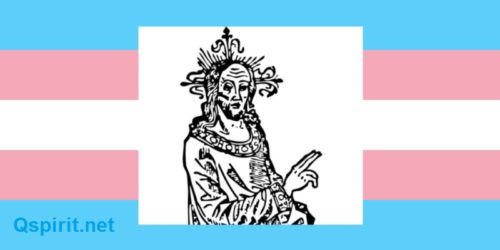
Early Christian cross-dressing monks are being reclaimed as possible transgender or LGBTQ saints. More than 20 saints share a similar story: They escaped their lives as women and lived as men, joining monasteries or becoming religious hermits. They usually spent the rest of their lives as men, often for decades. In most cases their biological sex was discovered by shocked communities after they died.
The church honors these queer saints for living holy lives, despite the Biblical prohibitions against women dressing as men in Deuteronomy 22:5. These intriguing saints were assigned female at death. They are usually venerated as women by the official church, but today they are sometimes categorized as transgender men, butch lesbians, transmasculine, nonbinary or genderqueer people.
People from history never fit neatly into contemporary categories, but these saints do show that Christianity has accepted and even celebrated people who lived differently from the sex that was assigned to them at birth.
These were not the medicalized gender transitions of today, and female saints may have adopted male personas for reasons that differ from the 21st-century transgender path. Historians say that they may have crossed the gender barrier because men were considered more holy back then and it was safer to be a man when travelling or living in the wilderness. Historians have not yet identified any male saints who lived their lives as women.
The male-to-female counterpart may be eunuch saints, such as the Ethiopian eunuch who was welcomed as an early church convert in Biblical times, Cosmas the Eunuch of sixth-century Palestine, and Chusdazat of fourth-century Persia. There were also male saints who wrote and spoke (metaphorically) of being female. For example, Francis of Assisi described himself as a “poor woman” when he met with the Pope and liked to be called “Lady Poverty.” Jerome, the fourth-century saint who translated the Bible into Latin, imagined himself as Mary Magdalene or the woman in Song of Songs… and there is a legend about how he was tricked into wearing a dress as a joke. Theodora and Didymus are fourth-century male and female Christian martyrs who exchanged clothes to help Theodora escape a brothel. Another idea about the lack of male-to-female saints is that they are “hiding in plain sight” because elaborate clergy robes allowed queer men to satisfy their need to dress in feminine style.
Biographies of transgender or cross-dressing saints
Here are short biographies of saints who crossed gender lines. The headlines are linked to full articles about them on Q Spirit if available. Q Spirit’s goal is to do complete articles on all of them in the future. Joan of Arc is a well known cross-dressing saint, but she is not included on this list because she never tried to pass as male.
Agnes of Moncada / Benjamin de la Cartuja
Agnes of Moncada (also known as Inés de Moncada and Inés Pedrós Alpicat) was a 15th-century Spanish saint who switched gender identities from female to male. When she was four years old, Agnes had visions of the baby Jesus. She wanted to devote her life to God, so she escaped a heterosexual marriage planned by her parents, and tried to enter a monastery as a man in the Valencian region of Serra. Rejection followed quickly when Agnes confessed. They made an agreement that the saint-to-be could live in a nearby cave in solitude as a hermit. Under the name Benjamin de la Cartuja, he lived and prayed there for 20 years until death in 1428 on his birthday, June 25. This holy person was not officially canonized, but is referred to as “Venerable.”
Anastasia / Anastasius the Patrician
Anastasia / Anastasius the Patrician of Alexandria is a sixth-century saint who was a lady-in-waiting to an empress before adopting a male identity as a eunuch monk in the Skete, an Egyptian desert region where many cross-dressing hermits lived. Anatasius lived in seclusion as a desert hermit for 28 years. The gender transition story came out to great acclaim after the saint’s death. This queer saint’s feast day is March 10.
Anna / Euphemianos of Constantinople
Anna / Euphemianos the New or Anna of Constantinople is an 8th-century saint who changed from female to male identity after her husband and children died. This saint’s feast day is Oct. 29. Adopting the male name Euphemianos, he joined a monastery and later lived in the wilderness of present-day Turkey.
Apollinaria / Dorotheos: Queer saint crossed gender line to become a monk in 5th-century Egypt
Saint Apollinaria or Dorotheos has been called a transgender icon or a cross-dressing saint. Assigned female at birth, Apollinaria adopted the name Dorotheos and entered a monastery as a man in fifth-century Egypt. Dorotheos’ father learned the secret when he accused the monk of getting his other daughter pregnant. Otherwise Dorotheos lived as a monk until death, when the full story became public. The story of Apollinaria / Dorotheos is similar to more than a dozen queer saints. This saint is honored by churches on Jan. 5-6.
Athanasia / Athanasius of Antioch
Athanasia / Athanasius of Antioch / Egypt was a 6th- to 9th-century Syrian married saint who separated from husband Andronicus to live as a male hermit in the desert. Oct. 9 is the feast day of this queer couple in the Catholic and Orthodox traditions. After 12 years apart, they reunited and lived as ascetics for 12 more years, but Andronicus never recognized his spouse until they were parted by death. A letter from “Father Athanasius” revealed the truth. Official accounts say, “The astonishment of Andronicus, as well as of the other hermits, was beyond description.”
Christina of Markyate
Christina of Markyate (c. 1096-1160), English anchoress who dressed as a man to escape heterosexual marriage. This queer saint’s feast day was probably Dec. 5.
Eugenia/Eugenios of Rome
Eugenia / Eugenios of Rome is an early Christian martyr who was raised female, became an abbot with a male identity, and was revealed to have a female body after false accusations of adultery. This queer saint’s feast day is Dec. 24-25.
Euphrosyne / Smaragdus of Alexandria
Euphrosyne / Smaragdus (Emerald) of Alexandria is a 5th-century saint who left life as a woman to become a monk in an Egyptian monastery. Today (Sept. 27) is this queer saint’s feast day in the Episcopal church. In an apparent acknowledgement of same-sex desire in monasteries, the abbot orders young Smaragdus to live in a separate cell to avoid arousing the other monks. After decades as a monk, Smaragdus was assigned to care for the saint’s own father, who still grieved the disappearance of his only child. He did not recognize Smaragdus’ as his own lost child until the saint revealed the truth to him shortly before dying. They reconciled and the father became a monk in the same monastery, living in Smaragdus’ old cell. The feast day for Euphrosyne / Smaragdus is Sept. 25 in the Greek Orthodox Church and Jan. 16 in the Roman Catholic church.
Euphrosyne the Younger / Johannes
Euphrosyne the Younger / Johannes (c. 854-923) avoided marriage to a man by putting on male clothing, adopting the name Johannes and sailing away on a ship to live as a monk and hermit. After many years this queer saint resumed a female identity, returned to Constantinople and lived as a celebrated wise woman and holy ascetic. This is NOT the same Saint Euphrosyne who adopted the male name Smaragdus. This queer saint’s feast day is Nov. 8.
Eusebia / Hospita / Xenia
Eusebia is a fifth-century saint who escaped marriage when she and two “maids” all adopted male identities. Eusebia asked to be called Hospita or Xenia, both names that mean a stranger. They left Rome and after much wandering they built a chapel in Milas (present-day Turkey) where they lived in community with religious women. Eusebia’s feast days are Jan. 24, Jan. 30 and Feb. 6.
Galla of Rome and Benedicta: Queer Roman saints — and lovers?
Galla of Rome was a sixth-century widow who avoided remarriage by growing a beard. She founded a hospital and convent, and begged to have her female beloved Benedicta accompany her into heaven. Galla’s feast day is Oct. 5 and Benedicta’s is May 6.
Hilaria / Hilarion
Hilaria / Hilarion is a fourth-century Egyptian saint who was raised as the daughter of Emperor Zeno, but transitioned to a male identity and lived in the desert as a monk known as Hilarion the Eunuch. Hilarion helps cast a demon out of his sister, who does not recognize her sibling. Their father objects to their intimacy, so Hilarion reveals the secret to his family and returns to life as a monk. This saint’s feast day is Jan. 29 in the Coptic church.
Hildegund of Shönau
Hildegund of Shönau near Cologne (also called Hildegonde of Neuss) is a German saint who was assigned female at birth but adopted the name Joseph and joined the Cistercian monastery of Schoenau near Heidelberg as a man. Hildegund/Joseph’s died on April 20, 1188 and has a feast day on April 20.
Hugolina/Hugo (Ugolina/Ugone) of Vercelli / Novaro
Hugolina of Novara, also called Hugolina of Vercelli (1239 -1300, Italy) “disguised herself as a man” and lived as a desert hermit. This queer saint’s feast day is Aug. 8.
Marinos / Marina the Monk: Transgender parenting role model and patron saint
Marinos or Marina the Monk has been called a patron saint of transgender parenting or a cross-dressing saint. Assigned female at birth, Marina adopted the name Marinos and entered a monastery as a man in fifth-century Lebanon. Marinos embraced a male identity from that point onward, even after being falsely accused of fathering a child. He adopted the boy and raised him as his own son. This queer saint is celebrated on June 18 in the Roman Catholic Church. Marinos is one of the most popular figures among about two dozen transgender or cross-dressing saints with similar stories. This queer saint is celebrated on June 17 in the Episcopal church, June 18 in the Roman Catholic Church and on other dates in other traditions.
Matrona / Babylas of Perge founded 4th-century convent of nuns who dressed as men
Matrona of Perge, who lived as a eunuch named Babylas, founded a convent where nuns dressed as men in 5th-century Constantinople. Nuns under the leadership of Matrona / Babylas were granted a unique privilege by the local abbott: “He did not give her woolen girdles and veils such as women were accustomed to wear, but men’s wide black leather belts and men’s white mantles. And these they wore continuously,” says an early source. The feast day of Matrona / Babylas is Nov. 9.
Papula of Gaul
Papula of Gaul is a sixth-century French saint who was beaten for being too religious while being raised as a girl, but escaped to join a monastery in Tours as a man. This queer saint’s feast day is Jan. 31. Gregory, bishop of Tours, praised Papula as “a man among men” (vir into viros) in a 6th-century hagiography. Papula was so virtuous that the other monks chose him as abbot. Papula spent 30 years at the monastery, keeping the secret until three days before dying, when he asked that women prepare his body for burial. Many miracles are said to have occurred at Papula’s tomb.
Paula Barbada
Paula Barbada is a sixth-century Spanish saint who dressed as a man, “equipped herself with a sword” and grew a beard to escape sexual assault by a man. Paula escaped into the hermitage of San Segundo in Avila and prayed for God to transform her. When the attacker entered, he perceived Paula as a man and left. Paula lived at the hermitage for the rest of their short life. Paula Barbara is honored locally as a saint with a Feb. 20 feast day. The well-known saint Teresa of Avila surely heard the legend of this queer saint.
Pelagia/Pelagios
Pelagia / Pelagios (or Margaret) the Penitent was a sex worker of 4th- or 5th-century Antioch who converted to Christianity and then moved to the desert and lived as a male hermit in a cave at Jerusalem. People were shocked to discover when Pelagia died that the holy ascetic man had a female body. This queer saint’s feast day is Oct. 8.
Susanna / John of Euthereoplis
Susanna / John of Euthereoplis was a deacon and martyr in third-century Palestine who left life as a woman to live as a male monk. This queer saint’s feast day is Sept. 19 or Dec. 15.
Theodora / Theodorus of Alexandria
Theodora/Theodorus of Alexandria, embraced as male identity and joined a desert monastery as a man, but was found to be a woman after death. Jan. 5 is the Episcopal feast day. It is Sept. 11 in other traditions.
Thecla of Iconium
Thecla or Thekla of Iconium is a first-century saint who is usually described as a young noblewoman who cut her hair short and dressed as a man to travel and spread the gospel. The Apostle Paul himself sent Thecla home to Iconium in present-day Turkey to continue preaching. Thecla gained a huge following and was the most prominent symbol of female empowerment in the early church. Thecla has been called a “transvestite saint and woman apostle.” Thecla’s feast day is Sept. 23 in the Episcopal and Catholic churches.
Wilgefortis: Holy bearded woman fascinates for centuries
Wilgefortis prayed to avoid marriage to a pagan king — and her prayers were answered when she grew a beard! Represented as a bearded woman on a cross, Wilgefortis has been popular since the Middle Ages, despite church disapproval. Legend says that Wilgefortis was the teenage Christian daughter of a king in medieval Portugal. She probably originates more in popular imagination than in history, but Wilgefortis continues to be an object of devotion in folk religion and a favorite character queer culture. Images of the bearded woman on a cross are plentiful across Europe and in Latin American folk retablos. Her alternate names include Uncumber, Liberata, Liberadamm Liverade, Kummernis, Komina, Beauvais, Comera, Cumerana, Debarras, Ulfe, Ohnkummer, Ontcommen, Ontcommere, Dignefortis, Europia, and Reginfledis. This virgin martyr’s feast day is July 20.
Xenia / Andrei of St. Petersburg: 18th-century widow adopted husband’s identity to become a queer saint and “holy fool”
Xenia / Andrei of St Petersburg is a queer 18th-century saint who married a soldier and assumed his identity after he died, becoming a “holy fool” who was canonized by the Russian Orthodox Church. The female-to-male saint showed up at the funeral in the husband’s military uniform, insisting on being called by his name and claiming that Xenia, not Andrei, had died. The saint gave away the family fortune and helped the poor and sick as Andrei for 45 years until death. This queer saint’s feast days are Jan. 24 and Feb. 6.
Resources on transgender or cross-dressing saints
For this article and many others, Q Spirit is indebted to the pioneering work of historian Paul Halsall, who taught at North Florida University in Jacksonville before returning to Manchester, England. He is known for the extensive network of history websites that he created in the 1990s, including the Calendar of Lesbian, Gay Bisexual and Transgender Saints, which is still the definitive resource on the subject. It is part of his larger Lesbian, Gay and Bisexual Catholic Handbook. Q Spirit also thanks Terence Weldon, a gay Catholic expert on queer saints who blogs at Queering the Church. His articles Trans saints? Cross-dressing monks and Trans in Faith: Early Cross-Dressing Saints and Martyrs are especially helpful
Medieval society was fascinated by female-to-male cross-dressing. “Clothes Make the Man: Female Cross Dressing in Medieval Europe” by Valerie R. Hotchkiss has a wonderful “Hagiographic Appendix” with short bios of no less than 34 “transvestite saints.” All of them involve some form of cross-dressing to serve God, protect their virginity or avoid marrying a pagan.
Another helpful article is “The Little Known History of Transgender Saints” in the Advocate. It is written by Roland Betancourt, art history professor at University of California, Irvine and author of the 2020 book “Byzantine Intersectionality: Sexuality, Gender, and Race in the Middle Ages.” The chapter titled “Transgender Lives” covers narratives of trans and gender-nonconforming monks plus gender-affirming practices by ascetic action and surgery.
“Saints’ Lives and the Rhetoric of Gender: Male and Female in Merovingian Hagiography” by John Kitchen puts “the female saint in a male corpus” into scholarly historical perspective.
Transgender Christian books: New in 2023
“Forward!: Thoughts of a Trans Woman on the Christian Journey” by Lynn Elizabeth Walker. Foreword by David E. Weekley. Published by Resource Publications, an imprint of Wipf and Stock.
“Raising Kids beyond the Binary: Celebrating God’s Transgender and Gender-Diverse Children” by Jamie Bruesehoff. Published by Broadleaf Books.

“Josephine: A Trans Story of Biblical Proportions” by J Mase III (author) and Wriply Bennet (illustrator).
Joseph, a popular figure in the Bible’s Book of Genesis, is a gender-nonconformist in this creative retelling. The book provides modern counter-narratives to dismantle anti-trans Biblical rhetoric. The author is a black/trans/queer poet. Raised in a Christian and Muslim home, Mase won a Lambda Literary Award for transgender nonfiction in 2020 for “The Black Trans Prayer Book.” It also appears on Q Spirit’s list of the top LGBTQ Christian books of 2020. Published by Tell Them I Was a Poet L.L.C.
Transgender Christian books and gifts: New in 2022
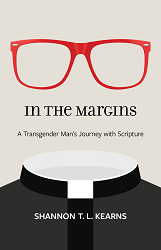
“In the Margins: A Transgender Man’s Journey with Scripture” by Shannon T. L. Kearns.
Biblical narrative blends with a transgender priest’s own life story in this trans reading of scripture. His experiences are woven together with Bible stories such as Jacob wrestling with the angel, Rahab and the Israelite spies, Ezekiel and the dry bones, and the transfiguration of Jesus. Raised in the fundamentalist evangelical tradition, Kearns was ordained as the first transgender priest in the North American Old Catholic Church and co-founded QueerTheology.com. His book “Queers the Word: A 40-Day Devotional for LGBTQ+ Christians” is on Q Spirit’s list of the top LGBTQ Christian books of 2020. Foreword by Paula Stone Williams, pastor and LGBTQ advocate. Published by Eerdmans, August 2022.
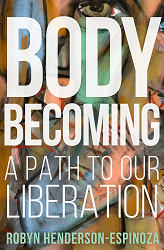
“Body Becoming: A Path to Our Liberation” by Robyn Henderson-Espinoza.
A non-binary transqueer Latinx theologian, activist and scholar weaves together memoir with theological reflection. The critical analysis provides fresh insights on embodiment, a core theme of Christian spirituality. The book considers which bodies count and why, the healing power of somatics, and embodiment as a vision for democracy. Based in Nashville, the author holds a PhD in religion from the University of Denver, attended Garrett-Evangelical Theological Seminary, and founded the Activist Theology Project. Published by Broadleaf Books, 2022.
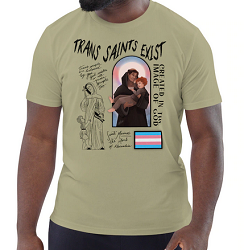
“Trans Saints Exist” shirt with Marinos the Monk by Dani.
Proclaim “Trans Saints Exist” with a stylish shirt featuring a new icon of Saint Marinos the Monk. “Trans people are beloved by God. God resides in all queer people too,” says the text. Marinos or Marina the Monk has been called a patron saint of transgender parenting. The design is as beautifully radical as the message. The shirt is created by Dani, an LGBTQ-affirming Catholic artist based in California. Assigned female at birth, Marina adopted the name Marinos and entered a monastery as a man in fifth-century Lebanon. Marinos embraced a male identity from that point onward, even after being falsely accused of fathering a child. He adopted the boy and raised him as his own son. The shirt and more icons by Dani are available at the And Her Saints shop on Etsy.
Transgender Christian books: New in 2021
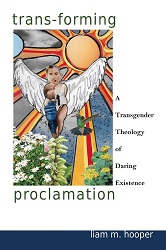
Interfaith
“Trans-Forming Proclamation: A Transgender Theology of Daring Existence” by Liam Hooper.
Gender-transcendent peoples in the Bible are at the center of this genre-defying book. Original, well-informed scholarship is woven together with theology, memoir and poetry in a bold and unique structure. Texts sacred to both Christian and Jewish traditions are explored. The author is a transgender advocate with a master of divinity degree from Wake Forest University in North Carolina. Formerly ordained clergy in the United Church of Christ, Hooper recently converted to Judaism. Published by Otherwise Engaged in December 2020.
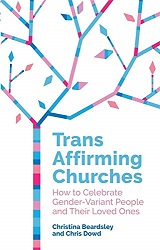
“Trans Affirming Churches: How to Celebrate Gender-Variant People and Their Loved Ones” by Christina Beardsley and Chris Dowd.
Churches can improve their relationships with trans people by using this guide. It is based on first-hand interviews, the authors’ own experiences and scripture analysis. . Dowd has pastored multiple churches and Beardsley is a Church of England priest. Together they also co-authored “Transfaith: A Transgender Pastoral Care Handbook,” which was on Q Spirit’s 2018 top books list. Beardsley’s book “This Is My Body: Hearing the Theology of Transgender Christians” was the number-one bestseller on Q Spirit’s 2016 top books list. Published by Jessica Kingsley Publishers.
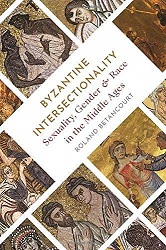
“Byzantine Intersectionality: Sexuality, Gender, and Race in the Middle Ages” by Roland Betancourt.
Queer relationships and identities in medieval times are revealed. The chapter titled “Transgender Lives” covers narratives of trans and gender-nonconforming monks plus historical gender-affirming practices by ascetic action and surgery. The “Queer Sensation” chapter explores same-gender desire and homosocial and homoerotic relationships in monastic communities by looking at how they portrayed the gospel story of Doubting Thomas. The final chapter examines stereotypes of gender and ethnicity in portrayals of the Ethiopian eunuch from Acts. The radically intersectional book puts sexuality and gender into the context of discourses on race, sexual and reproductive consent, bullying and slut-shaming. The author is professor of art history and at the University of California, Irvine. Published by Princeton University Press.
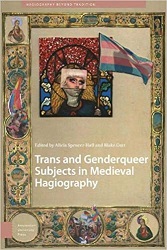
Note: Print book price is more than $100. But an open access free download is available.
“Trans and Genderqueer Subjects in Medieval Hagiography” by Alicia Spencer-Hall and Blake Gutt (editors).
The 2021 scholarly book uses queer theory to examine medieval texts by and about gender non-conforming saints who resisted the standard gender binary. The collection showcases scholarship by emerging trans and genderqueer authors, as well as established writers. Whole chapters are devoted to Mother Juana de la Cruz, Joseph of Schonau, Saint Katherine of Alexandria, Patriarch Ignatios (Ignatius of Constantinople), Euphrosine, Marinos the Monk and much more. Alicia Spencer-Hall is a fellow at Queen Mary University of London (UK) and Blake Gutt is a postdoctoral scholar at the University of Michigan. It was published by Amsterdam University Press.
More transgender Christian books
BESTSELLER AT Q SPIRIT
“Transfaith: A Transgender Pastoral Care Handbook” by Chris Dowd and Christina Beardsley with Justin Tanis.
This practical resource can help congregations welcome transgender people. Chapters cover terminology, church writings on trans people, theological reflections, Bible studies with discussion points, extensive bibliography, and liturgies such as a rite for preparation for surgery and a renaming ceremony, A chapter on transgender people in the United States is written by Tanis, who directs the LGBTQ center at Pacific School of Religion. Dowd has pastored multiple churches and Beardsley is a Church of England priest. Beardsley’s book “This is My Body: Hearing the Theology of Transgender Christians” was the #1 bestseller on Q Spirit’s Top 35 LGBTQ Christian books of 2016. Published by Darton, Longman and Todd, 2018.
BESTSELLER AT Q SPIRIT
“Transforming: The Bible and the Lives of Transgender Christians” by Austen Hartke.
Stories of Bible characters and transgender Christians alive today help equip readers to build a more inclusive church. The author is creator of the YouTube series “Transgender and Christian” and graduate of Luther Seminary’s Master of Arts program in Old Testament/Hebrew Bible Studies. Published by Westminster John Knox Press, 2018.
BESTSELLER AT Q SPIRIT
“Transfigured: A 40-Day Devotional for Gender-Queer and Transgender People” by Suzanne DeWitt Hall.
Be transfigured by the inclusive love and insights in this 40-day devotional for only $10. “Transfigured” is aimed at gender-queer and transgender people, but anyone will be blessed by its liberating scripture-based meditations. Meet “our gender-full God” and the Biblical eunuchs who became “non-binary heroes.” Discover how the Bible affirms gender complexity, transformation and freedom. Each day concludes with an inspirational quote from a variety of thinkers, from classics such as Saint Bonaventure and C.S. Lewis to contemporary trans trailblazers such as Austen Hartke and H. Adam Ackley. This is Volume 2 of the “Where True Love Is” series. The first volume was a bestseller on Q Spirit’s Top 25 LGBTQ Christian books of 2017. Foreword by Paula Stone Williams, a transgender woman, Colorado pastor and popular speaker on LGBTQ rights. The author is a freelance writer and HuffPost blogger who lives in Massachusetts with her wife. Published by DH Strategies, 2018.
BESTSELLER AT JESUS IN LOVE / Q SPIRIT
“This Is My Body: Hearing the Theology of Transgender Christians” by Christina Beardsley and Michelle O’Brien (editors).
Transgender Christians speak for themselves in this collection. They give voice to faith and theology grounded in specific yet diverse experiences beyond the usual gender identity imposed by church tradition. The book brings hope, anger and grace, plus a review of the latest theological, cultural and scientific literature. Many contributors come from the Sibyls, a confidential spirituality group for transgender people and allies in the United Kingdom. Foreword by Susannah Cornwall. Beardsley is a Church of England priest, hospital chaplain and activist for trans inclusion in the church. Raised Anglican, O’Brien does advocacy, research, lecturing and writing on intersex and trans issues. Published by Darton, Longman and Todd Ltd.
BESTSELLER AT JESUS IN LOVE / Q SPIRIT
“Transgender, Intersex and Biblical Interpretation” by Teresa Hornsby and Deryn Guest.
Biblical affirmation for LGBTQI people is presented by two well-known Bible scholars. They show that in the Bible, gender identity and sexual orientation are always dynamic categories that do, and must, transition. The book examines familiar (e.g., Gen 1; Revelation) and less familiar (2 Sam 6; Jer 38) scriptures to reveal the bias that makes heterosexuality and a binary two-gender system seem divinely ordained. They critique how biblical texts are used in Christian positional statements on transsexuality and provide statistic on violence against trans persons. Teresa Hornsby is religious studies professor at Drury University, Springfield, Missouri. Deryn Guest is lecturer in Biblical hermeneutics at the University of Birmingham, England. Published by SBL Press (Society of Biblical Literature, founded 1880).
“OtherWise Christian: A Guidebook for Transgender Liberation” by Mx. Chris Paige.
A comprehensive look at gender-nonconforming people in the Bible is provided in this new guide. Scholarly yet accessible, the book synthesizes 25 years of transgender-affirming biblical scholarship. Sections cover creation, clobber passages, eunuchs, and Jewish and Christian traditions, with an epilogue on “Living OtherWise Ever After.” The author co-founded TransFaith and published “The Other Side” magazine. Published by Otherwise Engaged in 2019.
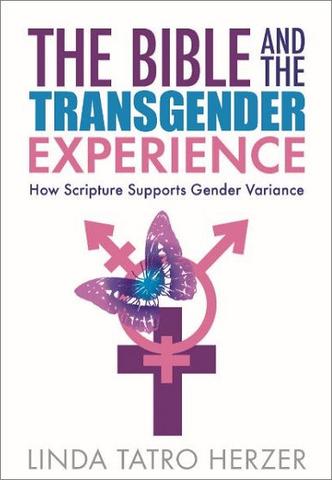
“The Bible and the Transgender Experience: How Scripture Supports Gender Variance” by Linda Tatro Herzer.
This clear, easy-to-read book shows how the Bible affirms transgender, queer and intersex people. Individual chapters examine eunuchs, Leviticus, cross-dressing, Jesus, creation, choice, gender-variant people in the Bible, and gifts that gender-variant people bring. It includes a helpful discussion guide and advice on “how to make your congregation or group trans friendly.” The author is an active ally who pastored a predominantly LGBTQI church where 10 percent of congregants identified as trans men, trans women, cross-dressers, or genderqueer. Published by Pilgrim Press.
“Trans-Gender: Theology, Ministry, and Communities of Faith” (2018 edition) by Justin Sabia-Tanis.
A classic is back. A trans clergy person explores the spiritual nature of transgender people and gives voice to their experiences with theological reflection on ministries by and for trans people. The book provides an intro to trans issues, an overview of gender variance and the Bible, guidance on how to build faith communities that welcome trans people, analysis of “gender as a calling” and transgender body theology. Scholarly yet accessible, the book was missed by many during the years it was out of print. The author is a United Church of Christ clergy who ministered at churches in Boston, Honolulu, and San Francisco; and is now managing director of the Center for LGBTQ and Gender Studies in Religion at Pacific School of Religion in Berkeley. The original 2003 edition was a finalist for a Lambda Literary Award and came from UCC publisher Pilgrim Press. The 2018 edition is published by Wipf and Stock.
“Retreating Forward: A Spiritual Practice with Transgender Persons” by David Elias Weekley.
A model for transformational retreats is presented in this educational resource for individuals, spiritual leaders, and faith communities that support transgender people. A queer theology of radical love is explained and put into practice. The author is a United Methodist pastor, transgender advocate and member of the transgender community. Foreword by British equality activist David Watters. Published by Wipf and Stock.
“Transgender Children of God” by Megan Rohrer.
Even a child can understand transgender identity with this heartwarming book aimed at kids ages 2 to 8. “Transgender children of God play with both dolls and trucks. No matter what you play with, God will love you,” it begins. The books goes on to proclaim God’s love regardless of what you wear, how you look or how you mix male and female. It also affirms transgender parents, although it can be read by any progressive family of faith. The author is pastor at Grace Lutheran Church in San Francisco and the first openly transgender pastor ordained in the Lutheran Church. Published by Wilgefortis/Lulu Press. Available in both paperback and e-book versions. For more info and a sample page, see First-ever LGBT religious children’s books published.

Book: Trans-Gendered: Theology, Ministry, and Communities of Faith (Center for Lesbian and Gay Studies in Religion and Ministry) by Justin Tanis

Book: Omnigender: A Trans-religious Approach by Virginia Mollenkott (2001)
Book: Transgendering Faith: Identity, Sexuality, and Spirituality by Leanne Tigert (editor)
Related links
Transgender Day of Remembrance: Spiritual resources (Q Spirit)
Transgender Day of Visibility celebrated with art, books and resources (Q Spirit)
___
This post is part of the LGBTQ Saints series by Kittredge Cherry. Traditional and alternative saints, people in the Bible, LGBT and queer martyrs, authors, theologians, religious leaders, artists, deities and other figures of special interest to lesbian, gay, bisexual and transgender and queer (LGBTQ) people and our allies are covered.
This article was originally published on Q Spirit in September 2019, expanded with new material over time, underwent a major update on Nov. 18, 2022, and was most recently updated on Feb. 20, 2024.
















Great article!
I do want to note that at the time of me writing this comment, the book “Trans and Genderqueer Subjects in Medieval Hagiography” by Alicia Spencer-Hall and Blake Gutt is an open access ebook and available for free on JSTOR.
You are so right! Here is the link to the open access free download. I also added it to the article. Thanks for reminding me about that this valuable resource is blessedly free now.
I was a priest in the tiny mountainous country of Lesotho, in the 1980’s. I was asked by one of the projects we ran, to come to do a burial in one of the really remote villages there. A very old woman, who had been “mother” to the village for a very long time had died. The whole village was mourning her death.
The village was so remote that I had to fly by helicopter to a nearby landing pad and then travel on a rough track by Basotho pony, for a long while.
When I arrived in the village, I found everyone in some kind of severe trauma. The teacher there was the only person with any English and she also seemed to be in a severe state of shock.
She seemed extremely uncomfortable about explaining to me what was going on.
Very slowly the story emerged. The woman who had died was well over 100 years old, but she had been in good health to the very end. She lived on her own and had never married. All her friends and relatives had died but she had been revered as the sort of village matriarch.
The women of the village had done the usual traditional rituals of preparing and washing her body for burial. And in doing so, had discovered that she was, in fact, a man!
The village was in a serious state of trauma. I threw away my prepared sermon and preached, instead, on Matthew 23:27-39, on the motherhood of God.
Lesotho was founded by a visionary king, Moshoeshoe I (pronounced Moshweshwe) who gathered together refugees from a number of other clans fleeing the Imperial designs and violence of the Zulu king Shaka. He led them to the inaccessibility and refuge of the mountains (incidentally, the “misty mountains” of JRR Tolkien).
In the 1980’s the Basotho welcomed thousands of refugees of all political persuasions, fleeing the terror of the Apartheid state in South Africa. The Christian Council of Lesotho was instrumental in facilitating the safe passage of thousands of them to Lusaka (mostly) where many of them received training in the military wing of the banned African National Congress.
Lesotho had remained separate from South Africa as a British Protectorate before gaining independence. But it was (and is!) a poor, mountainous, landlocked country with very little industry and mostly dependent on South African mines for jobs.
So the men are continual migrants, leaving their families for very long periods of time, returning home usually, only once a year for a brief holiday.
The women are left behind, literally holding the baby. So women develop extremely strong bonds, with the only males being children and the elderly.
With this old woman, there must have been some who knew her history. But the probability is that it was tacitly accepted. And then it just became the experienced reality.
In both South Africa and in Lesotho these situations tend to be tacitly accepted amongst black people. Interestingly, the more rural, the more accepting people are. In the cities, people are often prejudiced by churches against gay, lesbian and gender diversity.
I find it a bit odd to be quoted so much here and yet not named.
You are so right! I did link to your pages, but you should also be credited by name — and now you are, because I just updated this article. I added your name in several places, including this new paragraph in my introductory section:
For this article and many others, Q Spirit is indebted to the pioneering work of historian Paul Halsall, who taught at North Florida University in Jacksonville before returning to Manchester, England. He is known for the extensive network of history websites that he created in the 1990s, including the Calendar of Lesbian, Gay Bisexual and Transgender Saints, which is still the definitive resource on the subject. It is part of his larger Lesbian, Gay and Bisexual Catholic Handbook.
I want to use the correct citation, so please let me know if you want me to add any more of your bio or links.
I intend to rewrite this whole article myself in the near future, so it will no longer rely on extensive quotes from you and Terry Weldon. That approach is problematic in many ways, but it served to get Q Spirit started on this important subject. Your name was already listed as one of the resources at the bottom of the Saints page.
It’s an honor to know you read and commented my article. Along with the whole LGBTQ community, I am indebted to you for your pioneering work on saints. Thank you!
This article describes these saints’ motives as: “cross-dressing to serve God, protect their virginity or avoid marrying a pagan”, none of which have anything to do with a transgender identity. In some cases we have explicit descriptions of their motives: e.g. in the case of Joan of Arc there are several eyewitness accounts which quote her own explanation for continuing to wear a soldier’s riding outfit in prison : she was lacing it together to attach the long hip-boots, trousers, and tunic together to keep the English guards from pulling her clothing off during rape attempts. She always called herself “the maiden” (“la pucelle”) which removes any doubt about her self-identity. Calling all such people “queer” either ignores the context or expands the definition of “queer” to include almost anyone who has ever worn such clothing for practical reasons.
I’d say that the definition of “queer” has expanded.
(This is to Kittredge Cherry rather than to myself). Yeah, the definition of “queer” has “expanded” to the point that it could be applied to almost anyone, in this case people who wore clothing out of necessity. After such people get on a list of “queer icons”, people then jump to the conclusion that there must be solid evidence they were transgender, then they’re placed on lists of “transgender icons”, and the tale keeps on growing with more and more fiction being added with each retelling.